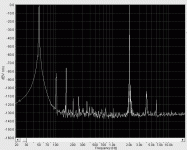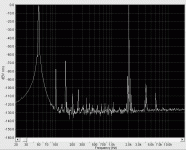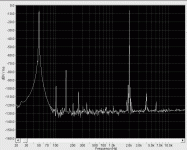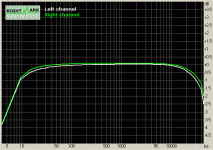john curl said:SY believes, everyone! I know that he has not 'proven' anything, but he believes that a 'good' transformer is an amazing adjunct to everyone's quality hi fi system. For some reason, what my associates and I have heard for the last 40 years doesn't count.
And who appointed you and your "associates" as the final arbiters for what sounds best to everyone?
How about if we nominate the Neutrik NTL1 as a contender for a fairly reasonably priced, small, professional grade input transformer? If not Neutrik, then what about Jensen or Cinemag? More expensive probably, and larger, but maybe, just maybe, measuring slightly better.
The CineMag CMLI-15/15B costs less than the NTL1 and has better performance (has a larger core than the NTL1).
Maybe we could get a group buy on the best of the contenders. Put me down for 2.
Been there, done that. You're a little too late.
se
You mean, I am left out? Oh well, back to the Blowtorch.
My latest and last customer has it now working in Hamburg, Germany. He had to hand carry (60lbs, 2 suitcases) it over with his luggage. Sooner or later, I might have to order some transformers for him, so that he can get his hi fi system to sound right. Maybe, he could hire SE as a consultant. He knows more about coupling transformers than I do.
My latest and last customer has it now working in Hamburg, Germany. He had to hand carry (60lbs, 2 suitcases) it over with his luggage. Sooner or later, I might have to order some transformers for him, so that he can get his hi fi system to sound right. Maybe, he could hire SE as a consultant. He knows more about coupling transformers than I do.
John, I believe my ears. I don't think you and your associates (hmm, has a bit of a Sopranos ring to it, eh?) were using modern input transformers 40 years ago, unless you had a time machine.
I've got lots of vintage units, I've listened to them, I've measured them- new is better.
Why not open your mind (and your ears) and actually try them? I would be delighted to give you a couple of Cinemags or Jensens if you'll actually use them. If you don't like the results, give 'em back, no problem.
I've got lots of vintage units, I've listened to them, I've measured them- new is better.
Why not open your mind (and your ears) and actually try them? I would be delighted to give you a couple of Cinemags or Jensens if you'll actually use them. If you don't like the results, give 'em back, no problem.
Stuart,
are you coming here in Prague in near future? I would be interested to try these transformers.
Pavel
are you coming here in Prague in near future? I would be interested to try these transformers.
Pavel
Any more transformer distortion measurements out there, Dimitri?
Oh well, back to the Blowtorch.
ok, as the owner of this thread you can show us BT distortion measurements, as an example to follow
Thanks for the input, Charles!
Right. Transformers aren't exactly Swiss Army knives and you can't expect to just stick them anywhere and expect to get the best performance out of them.
Have you looked at the iron-nickel Metglas 2826MB?
se
chascode said:Yes, the transformer HF peaking and distortion is very dependent on matching the driving circuit to the transformer's characteristic input impedance. The secondary RC network is used to minimize the HF peaking with the input and output impedances *exactly* as specified. The HF response will also degrade as the output impedance is reduced. I tested the Jensen CL-22R ISO-MAX and the Lundahl LL-1592 for audioXpress magazine and observed these potential application problems.
Right. Transformers aren't exactly Swiss Army knives and you can't expect to just stick them anywhere and expect to get the best performance out of them.
I have worked with just about every magnetic material there is. I don't particularly care for metglas (I used to work for AlliedSignal, who developed the amorphous metals, now Honeywell. But they since sold the whole metglas line to Hitachi I think.). It has a very low curie point and the various square-loop alloys are more non-linear than the cold-rolled >50% nickel core materials (orthonol, permalloy, mu-metal, etc.) used in audio transformers. Mostly they are used for pulse transformers and switching power supply magnetics. There is a more linear metglas alloy (2714A) used for some instrument transformers, but it is cobalt-based. Not ideal for audio.
Have you looked at the iron-nickel Metglas 2826MB?
se
PMA said:Pitty. Do you still have any co-operation here?
Not these days, no. But one never knows...
john curl said:Would you try it with a 2K source? That is the minimum Z that I can do today.
Here it is - for 2K2 source impedance. 1.4V RMS output (about 1.7 RMS on the input of the transformer and 2.05V RMS before 2K2 source resistor.
Alex
P.S. - increased noise level is due to an additional amplifier I had to connect to boost the signal.
Attachments
Some more pictures for 2K2 source and 10K load, now I had to resort to RMAA to get the frequency response quickly, without firing up HP3563A 🙂 . Right channel is a loop bypassing the transformer, left channel - through the transformer. HF rolloff is due to the amp used, LF rolloff is mostly due to the soundcard. Levels are matched by an additional attenuator for the R CH.
Alex
Alex
Attachments
x-pro said:
Oh, yes. That is exactly what I am trying to avoid by using these cuties 🙂 . I'll have no active stages on the input of ADC, just a transformer directly into a SAR ADC (no delta-sigma either). Just a fun project, for my own pleasure (and, hopefully, some vinyl back-up 😉 )
Alex
You are a smart man, I expect you will get great results.
I have had this idea for years but using discrete IP stage instead.
Which SAR are you planning to use?
When you downsample to 44.1 it might be worth trying the Tony
Faulkner program which averages a 176.4 down to 44.1 sans
filtering.
cheers
Terry
May we make a new thread?
Why not? The as-cast (non-annealed) type looked pretty good to me when I made a cursory glance at it a couple of years ago. I suppose excitation current is too high??
Have you seen any detailed information on the as-cast or the transverse-field annealed versions of this alloy? They look a little more practical than the super-high permeability type.
John
There is a more linear metglas alloy (2714A) used for some instrument transformers, but it is cobalt-based. Not ideal for audio.
Why not? The as-cast (non-annealed) type looked pretty good to me when I made a cursory glance at it a couple of years ago. I suppose excitation current is too high??
Have you looked at the iron-nickel Metglas 2826MB?
Have you seen any detailed information on the as-cast or the transverse-field annealed versions of this alloy? They look a little more practical than the super-high permeability type.
John
Now THAT rings a bell, doesn't it? 😉Terry Demol said:When you downsample to 44.1 it might be worth trying the Tony
Faulkner program which averages a 176.4 down to 44.1 sans
filtering.
- Klaus
SY said:Why not open your mind (and your ears) and actually try them?
Ever try using a 20MHz probe with a 100MHz oscilloscope? Even if his brain is the wonder analyzer he says it is the front end bandwidth ain't what it was.

- Status
- Not open for further replies.
- Home
- Amplifiers
- Solid State
- John Curl's Blowtorch preamplifier



